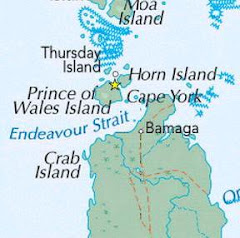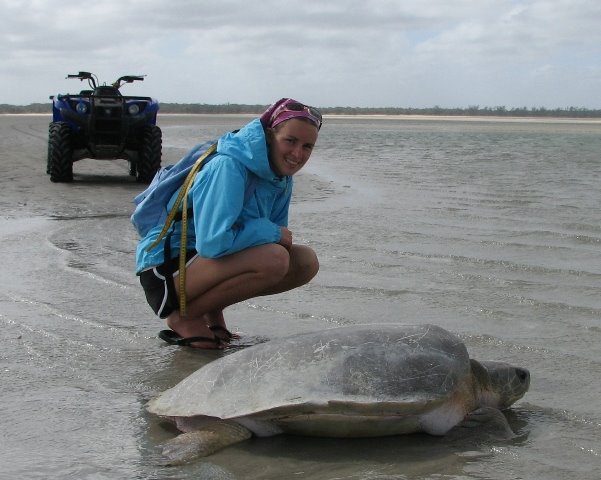Sunday, June 29, 2008
Winter nesting by flatback sea turtles on Crab Island
Tagging Flatbacks
The study of flatback sea turtles on Crab Island is further complicated by the large numbers of turtles coming ashore. In studying a large nesting population the use of tagging techniques which allow rapid identification and limit the likelihood of disturbing the nesting process is essential.
Furthermore, unlike the green turtle and hawksbill turtle which are traditionally harvested and therefore a higher rate of tag returns is recorded, flatback turtles are more of a cryptic species and little harvested. The tracking of migration distances and routes is difficult if relying on this technique alone. Satellite tracking of turtles will be necessary to determine movement patterns of individuals from the nesting beach.
Tuesday, June 24, 2008
Flatback facts # 1: White bellied sea eagles and juvenile flatbacks
Whatever way you look at flatbacks they are certainly a unique sea turtle. For example, all sea turtles have an oceanic phase in their lifecycle whereby they generally spend the first 10-15 years of their lives riding the ocean currents before settling in an inshore area. All except flatbacks that is. These juvenile years are known as the 'lost years' as little is known about this period of the sea turtle's life. This is certainly true with flatbacks. The evidence to suggest that flatbacks lack a pelagic phase came from an unlikely source - White-bellied sea eagles! Along the Great Barrier Reef sea eagle feeding sites were surveyed and a number were found to contain hatchling to juvenile size flatbacks (which there are very very few records of), leading to the theory that flatbacks remain within the continental shelf waters of Australia....!
Big grins and great people!
Cape York and the Torres Strait is an amazing part of Australia. The landscapes and the wildlife are worth the trip alone, but what I find most fascinating are both the Aboriginal and Torres Strait Islander cultures. I am always impressed with how friendly and welcoming the people of the northern peninsula and islands are. It is such a unique area, with Aboriginal and islander communities side by side, and a way of life and culture so different to the rest of Australia. You could easily be mistaken for being in another country! Indeed, the islands stretch only 150km to Papua New Guinea and trade still occurs between the islanders and the new guineans. It is remarkable how distinctive the cultures are.
If you have never been to this part of the world, it is well worth the trip - I'm sure you will be welcome with open arms!
Monday, June 23, 2008
Climate Change and Crab Island Flatbacks
Climate change has the potential to impact upon the Crab Island nesting population in a number of ways: mainly due to the loss of nesting (and feeding) habitats due to sea-level rise; and increased sand temperatures, which can lead to changes in sex ratios or potentially result in mortality. Importantly, part of this project will aim to quantify the impacts that climate change will have on flatback sea turtles in the area by the collection of baseline data, provide a model for assessing future climate change impacts, and begin to shape how conservation strategies are developed to protect the nesting population in the face of climate change.
Sunday, June 22, 2008
Blueys...the cutest hatchlings of them all..
Call me bias, but I think the flatback hatchlings are pretty cute. I must admit it's a close competition between the flatback and green turtle hatchlings, but I'm developing a real soft spot for the flatbacks. They have this amazing blue hue on their skin and scales, and big blueish-grey eyes.... and they are a truly Australian species, hence the nickname of 'Bluey'
Look at all those turtle tracks... nope, make that crocodile tracks!
In May when we did our first count of tracks around the island we came across a section of high density tracks heading up into the dunes. Assuming they were more turtles from the distance, it wasn't until we got closer that we realised that they were in fact crocodile tracks! At least 30 or more heading towards the same point over the dune. On closer inspection we found a wetland behind the dune with a small amount of water still in there. After throwing a couple of sticks to 'test the waters' for mud geckoes we ventured close enough to find a large number of dead fish. There were 3 species we counted, all brackish water fish. These had most likely been washed into the wetland during a tidal surge in the wet season and had died when the wetland dried up. The crocodiles had obviously had a nightly feast in the previous nights. Fascinating stuff!
Friday, June 20, 2008
Olive ridleys.... hmmm..
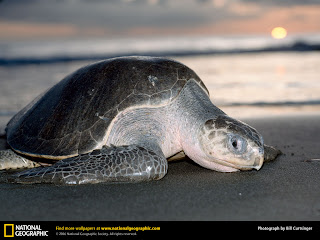
One of the highlights of the May 08 Seasonal study was the discovery of a high number of olive ridley nests. Olive ridley nesting in the Australia and South Pacific region is relatively uncommon, with only the odd nest being laid around the northern Australian coastline throughout the year.
Our first couple of nights surveying beaches saw us come across some high density nesting areas from previous nights. Excited to see ridleys nesting you could imagine my disapointment when we didn't see an olive ridley on the whole trip! I think we had missed the nesting event which had probably taken place
 around the new moon. Overseas in areas like Costa Rica ridleys are known to all nest at once in mass nesting events known as 'Arribadas'. The tracks, eggs and nests we recorded were far from the numbers witnessed in Costa Rica but it could be a similar behaviour where a lot of nesting occurs on the right tide, on the right moon at the right time of the year... be interesting to look more into this during the April/ May eriod next year...
around the new moon. Overseas in areas like Costa Rica ridleys are known to all nest at once in mass nesting events known as 'Arribadas'. The tracks, eggs and nests we recorded were far from the numbers witnessed in Costa Rica but it could be a similar behaviour where a lot of nesting occurs on the right tide, on the right moon at the right time of the year... be interesting to look more into this during the April/ May eriod next year...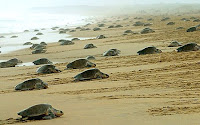

Organising for the 2008 field season..
This year is flying by! Having just returned from Crab Island it felt like the next trip was an age away, however it is ticking down very quickly and the 2008 nesting season is upon us already. I am getting excited about the upcoming trip - it will be the longest i have been on the island for and it is reasuring having the right equipment and knowing what needs to be done. As always there will be a few last minute things to work out, but come end August I should be set for a good 6 weeks of endless turtle tagging!
"Feral Pigs....they eat anything"
I think this photo Sam Prisk took while we were in Seisia, Cape York says it all. Drawn by one of the local kids and hung in the window of the local servo! Feral pigs, they do eat anything including sea turtle eggs. Pigs are a real menace on the Cape and a real risk to the existence of flatbacks. Close to 100% of nests laid on the mainland are dug up and eaten by feral pigs.

Thursday, June 19, 2008
surrounded by humpback dolphins..
Here is some interesting video of a couple feeding close to shore..
Prehistoric Battle...
Seasonal Study - May 08
Sam Prisk, Billy Leis and myself have just returned from a few weeks up on the Cape. It was a good time to be on Cape York as we were one of the first groups to be up there for this season after the roads had reopened following the wet season. There were no tourists and we virtually had the whole place to ourselves. For Sam and Billy it was their first time in this part of the world and their first experience with sea turtles and crocodiles. Sam's first crocodile was a 1.5m freshie we spotlighted along a creek on the way up, whilst Billy's first experience was with a 6m+ monster attacking a turtle on the beach on the first night on Crab Island! Needless to say all crocs looked small after that encounter and Billy didn't sleep well for a couple of nights!
A main objective of the trip was to document nesting density for that period of the year. Nesting numbers of turtles were impressive with 20-30 turtles nesting each night. This period seems to be the beginning of a long build up to the peak of the season towards August. We also discovered significant olive ridley nesting marked by a nesting event a couple of nights prior to our arrival. Unfortunately, we also identfied 100% predation on nests by feral pigs and goannas on the mainland.
As well, we documented some interesting crocodile activity and added a number of new fauna species to the Crab Island list, including amethyst pythons, northern tree snakes, Australian bustards, yellow footed scrub fowls, just to name a few..
Once again, we met some amazing and friendly characters in and around Seisia, Bamaga and Injinoo who were always willing to provide advice and assistance, or invite us to the local social gatherings!
Funding for satellite trackers!
The project was successful in a funding application to deploy 5-6 satellite transmitters. This was received through NRMWs budget for Biodiversity Projects on Cape York with Natural Heritage Trust funding.
It is unknown what feeding grounds supply the Crab Island rookery. My guess is that they will head north towards PNG/ Indonesia... can't wait to find out....!!!
Wednesday, June 11, 2008
Preliminary Scoping Study
A Preliminary Scoping Study was undertaken with Queensland Parks and Wildlife in August 2007 to determine the logistical requirements of the project and whether, in fact, the study was feasible. The challenge of the project exists namely with the remoteness, accessing the island, the large numbers of turtles nesting along a relatively long stretch of beach and the presence of saltwater crocodiles.
Myself, Ian Bell and Kelsey Verrillo braved the dubious crossings of the Jardine River and channel from the mainland to the island, and the ferrying of gear and equipment. What greeted us was close to 1000 turtles over 5 days with 1/4 of these nesting during daylight hours. What we also found was a real pattern in nesting with turtles emerging to nest in "waves". The earlier afternoon/ evening high tides saw a wave of turtles in the south of the island, whilst the later mid tide saw most nesting occurring towards the north of the island. This in many ways makes the collection of data more managable as all turtles aren't ashore at once each night.
The pattern of nesting is intrigueing, as it can really vary from day to day - one night there will be over 250 turtles nesting and then the next night only 50. The variables determining these nesting patterns are unclear, and it will be interesting to investigate further.
Crab Island is a place which is hides many mysteries and will yield many new discoveries..
Crab Island - The World's largest flatback sea turtle rookery

The flatback sea turtle is endangered with extinction. Known as ‘Australia’s Sea Turtle’, it is found only in the nation’s far northern waters. The world’s largest and most important nesting beach is on Crab Island, situated off the remote North West coast of Cape York.
The flatback remains a turtle of mystery. Biological information is critical to inform conservation strategies to ensure the species does not become extinct. This project aims to provide baseline data to increase our understanding of Crab Island's flatback sea turtles.



